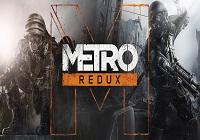Metro: Redux (Nintendo Switch) Review
By Renan Fontes  25.02.2020
25.02.2020

20th century American novelist John Gardner once claimed that there were only two kinds of stories: "a man goes on a journey, or a stranger comes to town." More than to an extent, Gardner is simply correct. Regardless of medium, how many stories can be boiled down to anything else? These are, of course, rather vague breakdowns on the part of Gardner, but his point is one about narrative structure and the universality of storytelling. At the same time, there's a stigma against video game writing, as if it is somehow inherently lesser. Although an adaptation of a novel, Metro's incredible script and atmospheric storytelling hopefully put those silly notions to rest.
In the case of Metro Redux, the story actually abides by both of Gardner's structural principles. A stranger comes to town, which in turn compels a man to go on a journey. Metro 2033 is the first half of the compilation, and arguably the real main draw of the two titles. While Last Light is a great FPS, 2033 is far more unique. It may not have the same quality of life fixtures as its sequel, but Metro opens with a truly unforgettable first instalment.
Two decades after nuclear war devastated the face of the planet, Earth is crawling with the mysterious 'Dark Ones;' demonic beings that violently rip apart everything in sight. Taking into consideration the dangerous mutated wildlife, humanity has no choice but to flee into the metros, building communities underground that keep mankind's culture alive as the world dies. It's a gripping presence, but it's one that only works half as well as it does because of downtime.
A considerable amount of gameplay is spent within these communities. Protagonist Artyom is 20 years old, and seeing the "world" for the first time. These metro communities are his only context for other cultures, other people. In-between traditional gameplay stages that involve combat and exploration, these metro sections are an opportunity to immerse in the post-apocalypse. These aren't barren video game towns either. Hotspots are packed with people who actively talk over one another. They aren't speaking gibberish either. They have full, discernible conversations that give the audience the impression that they're more than NPCs. They're real people who go about their lives, and Artyom only catches glimpses of that.
The inhabitants of the metro peddle and beg for money, they play music for crowds, and they go to bars to drink with their friends. Seldom will Artyom ever catch a name, but this just makes these brief interactions all the more meaningful. NPCs move and talk in real time. Artyom realistically can't be around for everything, but that just makes life in the metro all the more dynamic. It's always a thrill stumbling upon a new community and eavesdropping on whatever stories Artyom can catch in ear's reach.

Even the economy is interesting. Straight up ammunition is the currency, with Artyom needing to trade Military Grade Rounds for anything and everything. Bullets only make sense as currency in a post-apocalyptic environment, and this stands out as an endearing bit of world-building. More important than anything, these metro sections allow for one to decompress and prepare for the trials ahead. Metro 2033 can be very relaxing and moody in a positive way during these metro sections, but it's otherwise quite the overwhelming ordeal, dripping in a creepy atmosphere. Descending into the metros unprepared will only result in Artyom being torn limb from limb.
The core mechanics are rather typical for the FPS genre. Artyom can crouch, sprint, jump, and has access to regular and sub-weapons. Where the mechanics become interesting is in the introduction of resource management. Ammo is scarce, and blindly firing at everything will result in Artyom being left with no means of defending himself. Stealth is almost always an option fortunately, but there are narrative choke points designed to dwindle resources. As Artyom can carry three weapons at once, players should at least always have a fall-back, but it's just as important to make sure Artyom's guns all take different ammunition. Sometimes the difference between life and death is recognizing the foolishness of carrying two shotguns. There isn't too much gun variety, but all the basics are accounted for: handgun, shotgun, assault rifle, and flamethrower.
Although not present in the original release, Metro Redux adds Last Light's weapon customization into 2033. Artyom can purchase add-ons and upgrades for his guns, giving the otherwise simple gunplay more depth. Better yet, the inclusion of weapon customization gives Military Grade Rounds more value, adding another layer to resource management. Beyond bullets, resource management also extends to Artyom's sub-weapons and general equipment. Grenades and throwing knives spice up combat, but where grenades are exhausted once used, knives can actually be picked up so long as players take the time to find them after they're thrown. Knives can even kill enemies rather reliably, incentivizing stealth even more.

Arguably the most important resource at Artryom's disposal is his gas mask. Without his mask, Artyom cannot breathe the few times he goes up to the surface. The gask mask actually cracks with damage, fogs up, and needs to be replaced if it gets too worn out. Artyom also has to manage his air filters. Survival isn't as simple as putting on a mask. As filters operate on a timer, there's always a foreboding tension at play whenever Artyom has to put it on. 2033's open level design encourages exploration with genuinely useful rewards, but taking the time to explore means eating up a filter. Worse yet is if a player takes time to explore only to find nothing - but that in itself is part of the experience. Russia is a hostile, overrun environment. Exploration shouldn't be easy.
Some of the tensest moments come when exploring off the beaten path. What seems to be an abandoned building is quickly flooded with Lurkers; beasts that emit chilling shrieks whenever they stand on their hind legs. Lurkers suddenly swarm Artyom, and it's up to the player to either fight back with whatever ammo they have, or try to find safety. Moments like these can be overwhelming, but they add to the scope of Metro's apocalypse, emboldening the story's horror. On that note, for as engaging as the core gameplay is - from taking in the daily life of the metros, to exploring the surface amidst Dark Ones - the story is the real start of Metro 2033. Artyom's arc is one of the most compelling takes on the coming of age story in the medium. Across every chapter, players can find logs written by Artyom. While he's otherwise a silent protagonist, these files shed a considerable amount of light on who he is and the world around him.
Artyom isn't some hot-blooded FPS protagonist. He's a 20 year old who finds himself face to face with true, genuine horror. He eventually becomes something almost larger than life, but throughout the events of the first game, Artyom is a young man discovering the reality of the world around him. He carries a heavy burden, and his excellently written logs put other titles' in-game documents to shame.
Interestingly, 2033's story is rather spiritual in nature. Dark Ones aren't the only anomaly present in the post-apocalypse, ghosts infest the metro and their presence can often be unsettling. Their voices ring in Artyom's ears, sometimes even shaking the screen over a gradual black and white filter. More importantly, these ghosts are an opportunity to highlight the sorrow at the core of the narrative. Metro doesn't present post-apocalyptic life as glamorous. For as lively as the metro communities are, they're still dimly lit and uncomfortably packed. The surface doesn't fare much better either. Entire roads destroyed and Dark Ones and mutants making the Earth their territory. It's easy to slip into Artyom's boots and see the world how he sees it.

With incredible atmosphere, a gameplay loop that strikes a balance between combat and downtime, and one of the best written stories in the genre, Metro 2033 is a must play; but what of Last Light? Set a year after the events of the first game, Artyom finds himself dealing with the aftermath of 2033's finale. Notably, the sequel drops the spiritual flaring in favour of a more personal and politically driven plot. The script is just as well written, but grounded in something more palatable for the general audience. It is a shame to lose that unique bit of atmosphere- and the story as a result isn't as memorable - but Artyom's arc is a logical continuation of where he left off, and Last Light otherwise feels like a technical improvement all around.
Gunplay simply feels better, there are more guns to play with, there's better enemy variety, the art design is more striking, and there's an in-depth morality system. To be fair, 2033 also has a morality system, but it's rather typical for the medium. LL's is a different beast entirely, so subtle that it'll be bound to frustrate anyone aiming for a specific ending on their first play-through. Everything Artyom does, from playing instruments to killing certain enemies, will affect the final outcome. The first title featured multiple endings as well, but they're far more demanding in the sequel. Players have to work, and work hard. In a way, it's refreshing to see a morality system that requires some actual effort on the player's part. With resource management nowhere near as intensive, the revamped morality system almost takes its place in the gameplay loop.
If there's one area where Last Light is worse than its predecessor, however, it's in regards to pacing. 2033 is a brisk game that'll clock in at around 10 hours. There isn't a single moment of wasted space. Every single chapter contributes to both the story and the gameplay. The same praise cannot be extended to Last Light, a considerably longer game that outstays its welcome. At the end of the day, it's still one of the better FPS campaigns out there, yet it doesn't leave as strong an impression as 2033. But what does?

Cubed3 Rating
Exceptional - Gold Award

Between 2033 and Last Light, Metro Redux is a must buy for fans of the genre, fans of the medium, and fans of good stories. Metro's script is at times bone chilling, using atmosphere masterfully and showcasing a post-apocalyptic world with a true sense of community. Metro 2033 is the stronger of the two, making better use of both the setting and resource management, but Last Light nonetheless stands out as an incredibly well designed FPS, never lacking in the spirit that made its predecessor so compelling. Played back to back, Metro Redux tells a compelling, chilling story that'll stick with you long after the credits roll.

![]() 9/10
9/10
![]() 0
(0 Votes)
0
(0 Votes)
 Out now
Out now  Out now
Out now  Out now
Out now  Out now
Out now Comments
Comments are currently disabled

 Sign In
Sign In Game Details
Game Details Subscribe to this topic
Subscribe to this topic Features
Features







 Top
Top

